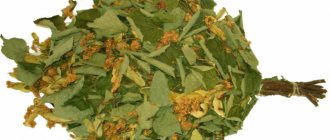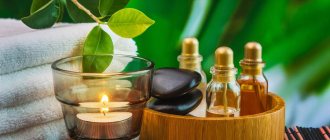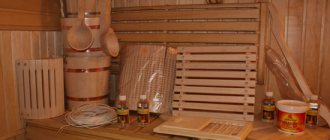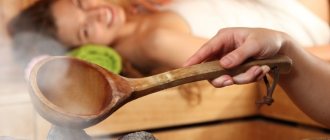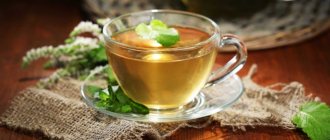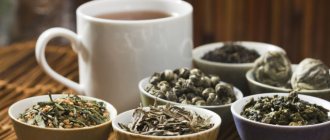Once you enter the steam room, heavy thoughts disappear from your head, your mood improves, and your body relaxes. In many ways, this is facilitated by the very atmosphere of the bathhouse, its spirit. To enhance this effect, the ancient Aztecs threw bunches of dry grass onto the coals, and our ancestors used various types of firewood and brooms, or watered the stove with water in which medicinal herbs were steamed. Later, the herb that was brewed for use in the steam room began to be called “sauna brew.”
Herbs for baths
Wormwood is most often used in the bath, as the herb has antiseptic properties.
It is capable of destroying many types of bacteria and harmful microorganisms when inhaling its vapors, and also helps to relax and calm the nervous system.
This plant is successfully used for the following diseases:
- Rheumatism;
- Diseases of the cardiovascular system;
- Colds.
Regular use of it in the bath will be an excellent prevention against viral and bacterial infections during the cold season. Aromatherapy in a bath with this type of herbs will improve performance and strengthen the immune system.
Another herb that is actively used in bath procedures is mint, which has a disinfectant effect, improves the functioning of the digestive tract, relieves nausea, and normalizes the functioning of the heart and lungs.
Melissa is also often used in the bath, which calms the nervous system and irritated skin, relieves tension, relaxes muscles, and has a beneficial effect on sleep.
Types of plant essential oils
Each plant contains essential oils that act on the human body. Therefore, before visiting steam rooms or saunas using herbal teas, it is necessary to carefully study their composition and effect. The result of your visit will depend on this knowledge, whether you will enjoy it or have health problems.
So, below are the characteristics of some herbs with essential oils.
One of the leading places is occupied by coniferous parks. Their effect is to relieve tension and fatigue after a difficult week of work. They also partially have antimicrobial properties, which plays an important role in cases of weak immunity.
Peppermint is one of the most powerful sources of essential oils. It is highly effective in the treatment of colds, alleviates diseases of the upper respiratory tract, and has invigorating and tonic properties.
Eucalyptus has an additional and strengthening effect on a sore throat, bronchi, cough and similar phenomena. The high content of essential oils in it provides an antimicrobial and anti-inflammatory effect.
Chamomile, familiar to us since childhood, calms and disinfects the skin well.
Hops help relieve stress after a hard day and stimulate the immune system.
Wormwood essential oils do an excellent job of relieving headaches and increasing the body's performance.
Linden promotes the active removal of fluid, which promotes weight loss, has a calming effect, and has proven effective in the fight against insomnia.
The use of meadowsweet helps relieve inflammation, improve the structure and condition of hair.
The use of sweet clover has a beneficial effect on high blood pressure, bringing it back to normal, helps eliminate convulsive reactions, helps cope with diseases of the upper respiratory tract, has proven effective in the fight against skin inflammation in the form of boils, abscesses, and accelerates the process of maturation of abscesses.
A lifesaver for people who have problems with the musculoskeletal system is cinquefoil. It eliminates pain in joints, intervertebral discs, arthrosis, arthritis, rheumatism, radiculitis, osteochondrosis.
Therefore, based on individual need, the appropriate herb or herb mixture should be carefully selected so that it benefits each individual or all members of the company.
Composition and properties of wormwood
Wormwood is one of the oldest and medicinal plants on the planet; the following components can be found in its composition:
- Natural amino acids;
- Organic acids;
- Potassium salts;
- Vitamins (A, B, C);
- Tannins;
- Minerals;
- Proteins;
- Resins;
- Bitter glycosides;
- Flavonoids;
- Alkaloids;
- Phytoncides;
- Saponins.
Thanks to such a rich composition, the use of wormwood for a bath can provide such beneficial properties as:
- Toning the body;
- Normalization of the activity of the central nervous system;
- Elimination of pain and spasms;
- Diuretic effect;
- Antifungal action;
- Anti-inflammatory effect.
Types of wormwood
Science identifies approximately 400 species of this plant, and approximately 150 of them grow in Russia. In folk medicine, the following types are most often used:
- Medicinal;
- Bitter;
- Paniculata;
- Lemon.
Medicinal
This type of grass grows on roadsides, in gardens, and wastelands. Healing decoctions are made from it, which are intended to improve appetite and eliminate nervous disorders.
Gorkaya
This plant variety has a specific smell and bitter taste. It can grow anywhere, in forests, fields, meadows, cultivated soil and wild. Preparations and folk remedies containing it in their composition successfully fight epilepsy, help get rid of insomnia, depression, strengthen the immune system, destroy parasites, and treat women's diseases.
Paniculata
Paniculata blooms from July until late autumn.
In folk medicine, it is used to make wormwood brooms for baths to treat rheumatism and respiratory diseases.
In order to use the plant for medicinal purposes, only its flowers, stems and leaves should be collected.
Lemon
Lemon wormwood or abrotan has been known to people since antiquity; its healing decoction was drunk for snake bites and fever. Also, this particular type of wormwood is used to prepare seasoning; it is from it that essential oil is obtained.
Procurement of raw materials
As we have already noted, it is necessary to cut the shoots of this plant so that, on the one hand, they accumulate the maximum amount of useful substances, and on the other, the above-ground parts acquire sufficient strength for further use as a bath broom. It is worth noting that this period, to a greater extent, occurs from the beginning of flowering to the formation of seeds.
To make a broom, wormwood for a bath is cut to a length of 50 - 60 cm, counting from the top of the shoot. Wastelands should be considered the most favorable for harvesting, since along roadsides and between fields, plants can be exposed to a number of unfavorable factors of an endogenous nature.
A prerequisite for preserving high-quality raw materials is to lay out the collected mass in a small, loose, highly permeable layer under sheds and in attics, in order to dry it as quickly as possible. The end of this process should be considered the moment when the stems acquire the ability to break. The brooms are tied with jute twine, forming a handle with a diameter of no more than 5 cm.
Store the wormwood broom in the technical room of the bathhouse, which is sufficiently ventilated and does not have high humidity. You should not neglect periodic inspections of the products, since grass brooms are more susceptible to the risk of rot than from tree shoots. As a preventive measure in the fight against insects, such raw materials can be placed in other rooms of the bathhouse, in particular, in dressing rooms or rest rooms.
Indications for use
The medicinal plant is used for the following types of ailments:
- For stomach diseases;
- For fever;
- With neurasthenia;
- For parasitic infestations;
- For tuberculosis.
For stomach diseases
A herbal decoction successfully fights pain and cramps in the stomach if taken three times a day. The plant also helps cure digestive disorders, flatulence, and inflammation of the rectum. You can take it in the form of wormwood tea or alcohol tincture.
Important! A medicine made from wormwood in powder form is well suited for treating the stomach, since it is this form that penetrates into all parts of the gastrointestinal tract, including the lower ones.
For fever
For this type of disease, wormwood is used as an antipyretic.
For neurasthenia
Wormwood infusion is good for neuroses, insomnia and migraines. Baths and saunas with wormwood are also used for these purposes.
Also, a tincture of this herb in alcohol helps fight depression and improves body tone.
For parasitic infestations
When infected with worms, this herb is an indispensable, and most importantly, completely natural remedy. To destroy parasites from wormwood, cloves and tansy, a special composition is prepared, which causes the death of both adults and larvae and eggs.
Important! Despite the fact that the medicine for parasites contains only natural ingredients, it should be taken with caution, so you should consult your doctor before using it.
For tuberculosis
As an adjuvant therapy, wormwood decoction is often prescribed in the treatment of tuberculosis and other lung diseases.
Proper brewing of medicinal plants
In order for herbs and plant mixtures to bring maximum benefit, they need to be brewed correctly. Do you know how to prepare a decoction and tincture? No? Great, now let's learn! Wait a minute, does everyone know how to brew tea? Okay, okay, convinced. Then let's get started.
Preparation of decoctions
To brew the decoction, take:
- fresh, frozen or dried plant - 1-2 tbsp. l.;
- water – 1 l.
The grass is poured into the pan and filled with water. The components are mixed well. The container is tightly covered with a lid and placed on the stove. The broth is prepared for 20–30 minutes over low heat. Then the aromatic and healthy drink is cooled, filtered and poured into a thermos.
Preparation of tinctures
To prepare the tincture we stock up on:
- herbs – 1–2 tbsp. l.;
- water – 1 l.
Water is poured into the kettle, placed on the stove and brought to a boil. The grass-ant is poured into a jar and boiling water is poured. All ingredients are mixed. The container is covered with a lid and wrapped in a towel or woolen scarf. The product is infused for 1–2 hours. Then it cools, filters and pours into a thermos.
That's all. Such simple manipulations can be done by everyone. It is so?
Features of a wormwood broom
Each bath broom has its own characteristics, for example, one made from wormwood has a strong odor, which ensures air disinfection. But this aroma may not be to everyone’s taste; those who react sharply to various strong odors should avoid using it.
Due to the fact that wormwood is a grass, a broom made from it will be extremely fragile and can only be used once.
Experts recommend adding a few twigs of wormwood to regular classic birch brooms , so the smell will be less pronounced, the broom itself will be durable, and the beneficial effect will remain.
When to harvest wormwood for brooms
Most people know how to use wormwood in a bath, but not everyone knows when to collect it in order to make a broom. Suitable types of herbs for making brooms include paniculata, bitter, lemon, and medicinal.
You should start making a broom when the plant has finished flowering. The timing of its flowering varies for each species, the approximate period being from July to October. The grass should be collected before it has time to dry; it should be dried in a cool, dark place.
How to make a park with your own hands?
Knowing which herbs can be used for a bath, it is easy to prepare a bath infusion with your own hands. First of all, you will need dried herbs for this. You can purchase it at the pharmacy or prepare it yourself.
In the first case, you need to pay attention to the shelf life of pharmaceutical raw materials and their storage conditions. Preference should be given to hermetically sealed (wrapped in film) boxes in which the grass is packaged in bulk. Herbs in individual bags are less suitable for making teas, because due to the high degree of grinding they in most cases lose their aroma.
If you harvest the grass yourself, you must follow the rules and terms for its collection. Most plants are harvested during the flowering period, preferably in the morning, in dry weather. Herbs should be dried in a well-ventilated area, preferably hanging. You can lay out plants on paper or fabric, but on the condition that they are regularly turned over and the lining is changed.
When the herb is prepared, you will need small (about 3x7cm) linen bags. The ideal option is bags made of burlap or canvas; they will allow water to pass through well. But you can sew them from chintz, cotton fabric or old waffle towels. For each bag you need to prepare a tie so that you don’t have to look for it later.
Important! The bags should be well stretched and ironed on both sides. This will prevent the herbs from being spoiled by mold fungi and other microorganisms.
Having finished with the preparations, you can begin the process of creating steaming. For this:
- the prepared herbs are crushed, the optimal particle size is about 3x3 mm;
- Spoon the crushed herbs into bags; you can mix several types of herbs in one bag;
- The bags are tightly tied with a drawstring.
Ready! All that remains is to sign the bags and put them away for storage in a safe, not damp, place.
Contraindications
The benefits and harms of wormwood in the bath have long been one of the most discussed issues. Taking a steam bath using this plant is not recommended for pregnant and lactating women, those people who suffer from asthma, stomach ulcers, anemia, or who are allergic to this herb.
They should also refrain from taking medications with this plant. Wormwood is a fairly useful whole plant and can help cure many diseases, but it also has a specific smell and some restrictions on taking medicines from it and bathing procedures using it.
In order for therapy with this herb to be successful and not cause side effects, proportions and dosages must be observed when preparing various potions from it.



